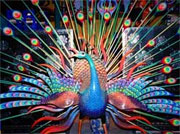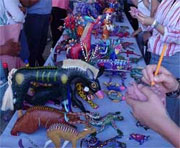Home » Mexico Destinations » Oaxaca » Oaxaca Attractions » Alebrijes
Alebrijes
 The alebrije (ali-bre-haze) name is often used in reference to the fanciful woodcarvings created by artists in Oaxaca, Mexico. These popular folk art wood sculptures are also known as animalitos, monos, or simply figuras. While most share the bright colors and fanciful subjects popularized by Linares work, individual artists generally have very distinctive carving and painting styles. Manuel Jimenez is recognized as the founder of folk art woodcarving in Oaxaca. Like Linares, Jimenez progressed from carving simple pieces in the local tradition, to creating internationally-recognized works of art. Inspired by the woodcarving of fellow Oaxacan Don Pascual Santiago and the papier mache work of Pedro Linares, Jimenez began carving stylized monkeys (monos) and other creatures in the 1960s. His critical and financial success spawned a new industry for small villages in one of Mexico's poorest regions. There are now over 200 woodcarving families concentrated in the villages San Antonio Arrazola, San Martin Tilcajete, La Union Tejalapa, and San Pedro Cajonos.
The alebrije (ali-bre-haze) name is often used in reference to the fanciful woodcarvings created by artists in Oaxaca, Mexico. These popular folk art wood sculptures are also known as animalitos, monos, or simply figuras. While most share the bright colors and fanciful subjects popularized by Linares work, individual artists generally have very distinctive carving and painting styles. Manuel Jimenez is recognized as the founder of folk art woodcarving in Oaxaca. Like Linares, Jimenez progressed from carving simple pieces in the local tradition, to creating internationally-recognized works of art. Inspired by the woodcarving of fellow Oaxacan Don Pascual Santiago and the papier mache work of Pedro Linares, Jimenez began carving stylized monkeys (monos) and other creatures in the 1960s. His critical and financial success spawned a new industry for small villages in one of Mexico's poorest regions. There are now over 200 woodcarving families concentrated in the villages San Antonio Arrazola, San Martin Tilcajete, La Union Tejalapa, and San Pedro Cajonos.
Carving Alebrijes
 Most Oaxacan carvers use wood from the Copal tree. Copal (or Copalillo) belongs to the Bursera genus and is found primarily within the warm regions of Oaxaca. The wood from the female trees has few knots and is soft and easy to carve when it is first cut. Once dried, it becomes light, hard, and easy to sand smooth. One drawback, however, is that it can harbor the powder post beetle. The wood is often treated with chemicals before being painted and finished pieces can be frozen for 1-2 weeks to kill any eggs or larvae that might be present. Some artists now use other woods--Manuel Jimenez and his sons switched to cedar and some artists import hardwoods. Pieces are carved using machetes and knives. Carvings created from a single piece of wood are normally considered of higher quality than those assembled from multiple pieces, although elements such as ears and horns are frequently carved separately and fitted into holes so they can be disassembled and shipped safely. Finished pieces are typically hand-painted with acrylics. Acrylics are now favored over natural aniline dyes because the colors are not as prone to fading.
Most Oaxacan carvers use wood from the Copal tree. Copal (or Copalillo) belongs to the Bursera genus and is found primarily within the warm regions of Oaxaca. The wood from the female trees has few knots and is soft and easy to carve when it is first cut. Once dried, it becomes light, hard, and easy to sand smooth. One drawback, however, is that it can harbor the powder post beetle. The wood is often treated with chemicals before being painted and finished pieces can be frozen for 1-2 weeks to kill any eggs or larvae that might be present. Some artists now use other woods--Manuel Jimenez and his sons switched to cedar and some artists import hardwoods. Pieces are carved using machetes and knives. Carvings created from a single piece of wood are normally considered of higher quality than those assembled from multiple pieces, although elements such as ears and horns are frequently carved separately and fitted into holes so they can be disassembled and shipped safely. Finished pieces are typically hand-painted with acrylics. Acrylics are now favored over natural aniline dyes because the colors are not as prone to fading.